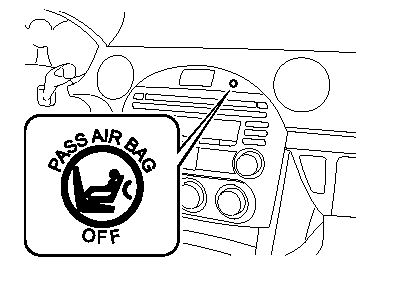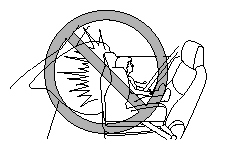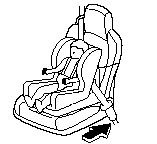Child Restraint Precautions
Mazda strongly urges the use of child-restraint systems for children small
enough to use
them.
You are required by law to use a child-restraint system for children in the U.S. and Canada.
Check your local and state or provincial laws for specific requirements
regarding the safety
of children riding in your vehicle.
Whatever child-restraint system you consider, please pick the appropriate one
for the age
and size of the child, obey the law and follow the instructions that come with
the individual
child-restraint system.
A child who has outgrown child-restraint systems should use seat belts, both lap
and
shoulder. If the shoulder belt crosses the neck or face, move the child closer
to the center of
the vehicle.
A rear-facing child-restraint system should NEVER be used on the passenger seat
with the
air bag system activated.
If a small child or infant in the passenger seat ― particularly a child secured
in a rearfacing
child-restraint system ― it is critically important that you consciously
deactivate the
passenger air bag and not simply rely on the passenger air bag deactivation
indicator light
being turned on at all times. In a collision, the force of an air bag slamming
the childrestraint
system rearwards could result in death to the child even if the child is
properly
belted. Be alert to the operation of the indicator light and BE SURE THE
PASSENGER
AIR BAG IS ALWAYS DEACTIVATED AS INDICATED BY PASSENGER AIR BAG
DEACTIVATION INDICATOR LIGHT.

Passenger air bag deactivation indicator light
To reduce the chance of injuries caused by the deployment of the passenger
air bag, there
are two methods to deactivate the passenger air bag for a child's safety as
follows ―
however the surest way to avoid the passenger air bag not deploying is to use
the key and
turn off the passenger air bag and not rely on the passenger seat weight
sensors, which will
also detect other loads or objects on and around the passenger seat;
Passenger air bag deactivation switch
This switch should be used to deactivate the passenger front and side air
bags and also the
passenger seat belt pretensioner system if installing a child-restraint system
is installed on
the passenger seat.
Make sure the passenger air bag deactivation switch is in the ON position except
when a
child-restraint system is installed on the passenger seat.
Refer to Passenger Air Bag Deactivation Switch.
Passenger seat weight sensors
These sensors deactivate the passenger front and side air bags and also the
passenger seat
belt pretensioner system when the total seated weight on the passenger seat is
less than
approximately 30 kg (66 lb).
When an infant or small child is seated on the passenger seat, the system shuts
off the
passenger air bag, so make sure the passenger air bag deactivation indicator
light
illuminates.
Refer to Passenger seat weight sensors.
LATCH Child-Restraint System
We have installed lower LATCH anchor points for LATCH style junior seats and
infant
carriers that work without tethers only. Any other child-restraint system that
has an upper
tether cannot be used in this vehicle because there is no tether anchor. A
child-restraint
system with a tether cannot be properly mounted in this vehicle unless the child
restraint
manufacturer provides instructions on mounting the child-restraint system with
only seat
belts in automatic locking mode. Even then, without a tether, the
child-restraint system may
move forward more easily in seat belts, further degrading the safety provided if
you were to
put the child restraint in a tether anchor equipped rear seat of another
vehicle. The seat and
head restraint is designed for maximum adult space utilization in this vehicle.
Do not try to
secure the tether to something else in the vehicle, as too much slack will
result and the
serious risk of injury or death to the child. Use the seat belts to properly
secure the nontethered
child-restraint systems other than the LATCH junior seats and non-tethered
infant
carriers. Turn off the passenger air bag deactivation switch. To expose and use
the lower
LATCH anchor points, which are affixed to the body and not the seat, slide the
seat all the
way rearward which is the optimal vehicle seat position for all children in this
two seat car.
WARNING:
Use the correct size child-restraint system:
For effective protection in vehicle accidents and sudden stops, a child must be
properly restrained using a seat belt or child-restraint system depending on age
and
size. If not, the child could be seriously injured or even killed in an
accident.
Follow the manufacturer's instructions and always keep the child-restraint
system
buckled down:
An unsecured child-restraint system is dangerous. In a sudden stop or a
collision it
could move causing serious injury or death to the child or other occupants. Make
sure any child-restraint system is properly secured in place according to the
childrestraint
system manufacturer's instructions. When not in use, remove it from the
vehicle or fasten it with a seat belt, or latch it down to BOTH LATCH lower
anchors
for LATCH child-restraint systems.
Always secure a child in a proper child-restraint system:
Holding a child in your arms while the vehicle is moving is extremely dangerous.
No
matter how strong the person may be, he or she cannot hold onto a child in a
sudden stop or collision and it could result in serious injury or death to the
child or
other occupants. Even in a moderate accident, the child may be exposed to air
bag
forces that could result in serious injury or death to the child, or the child
may be
slammed into an adult, causing injury to both child and adult.
Always make sure the passenger air bag deactivation indicator light is
illuminated
when using a rear-facing child-restraint system:
Seating a child in a rear-facing child-restraint system that is installed on the
passenger seat with the passenger air bag deactivation indicator light not
illuminated is extremely dangerous. In an accident, a air bag could inflate and
cause
serious injuries or even death to the child seated in the rear-facing
child-restraint
system. Always make sure the passenger air bag deactivation indicator light is
illuminated using the key to turn the passenger air bag off.
Refer to Passenger Air Bag Deactivation Switch.

Refer to Passenger seat weight sensors.
Seating a child in a child-restraint system on the passenger seat is dangerous:
This vehicle is equipped with both a passenger seat weight sensor and a
passenger
air bag deactivation indicator light. Even with the passenger seat
weight
sensors, seating a child in a child-restraint system on the passenger seat under
the
following conditions increases the danger of the passenger air bag deploying and
could result in serious injury or death to the child. These are among the
reasons why
the passenger air bag should be turned off using the key.
 The total seated weight of the child with the child-restraint system on the
The total seated weight of the child with the child-restraint system on the
passenger seat is approximately 30 kg (66 lb) or more with a child in the
childrestraint
system.
 Luggage or other items are placed on the seat with the child in the
Luggage or other items are placed on the seat with the child in the
child-restraint
system.
 The seat is washed.
The seat is washed.
 Liquids are spilled on the seat.
Liquids are spilled on the seat.
 The passenger seat is moved backward, and it is pushed into luggage or other
The passenger seat is moved backward, and it is pushed into luggage or other
items placed behind it.
 Luggage or other items are placed between the passenger seat and center
Luggage or other items are placed between the passenger seat and center
console.
 Any accessories, which might increase the total seated weight on the passenger
Any accessories, which might increase the total seated weight on the passenger
seat, are attached to the passenger seat.

Before installing child-restraint system on the passenger seat, move the
passenger
seat as far back as possible:
In a collision, the force of a deploying air bag could cause serious injury or
death to
the child. Make sure that the passenger air bag deactivation switch is in the
OFF
position. Refer to Passenger Air Bag Deactivation Switch.
Do not allow a child to lean over or against the side window of a vehicle with
side air
bags:
Allowing anyone to lean over or against the door is dangerous. If the vehicle is
equipped with side air bags, the impact of an inflating side air bag could cause
serious injury or death to the person. Children are more likely to sleep in the
vehicle;
when they do, they are more at risk in the passenger's seat that has a side air
bag
because they may slump over into the path of the seatback-mounted air bag.
Furthermore, leaning over or against the doors could block the side air bag and
eliminate the advantages of supplemental protection. Because the side air bag
deploys from the outboard shoulder of the seat, do not allow the child to lean
over or
against the side window, even if the child is seated in a child-restraint
system.
Never use one seat belt on more than one person at a time:
Using one seat belt for more than one person at a time is dangerous. A seat belt
used in this way cannot spread the impact forces properly and the two passengers
could be crushed together and seriously injured or even killed. Never use one
belt for
more than one person at a time and always operate the vehicle with each occupant
properly restrained.
Always use a child-restraint system designed for use without a tether:
Using a child-restraint system that requires a tether is dangerous. Your Mazda
does
not have a child-restraint tether. The child-restraint system cannot be properly
secured. In a collision, it could move and injure other occupants as well as
result in
serious injuries or death to the child.
CAUTION:
A seat belt or child-restraint system can become very hot when exposed to direct
sunlight during warm weather. To avoid burning yourself or a child, check them
before you or your child touches them.
NOTE:
Your Mazda is equipped with LATCH lower anchors for attachment of specially
designed LATCH
child-restraint systems behind the passenger seat that slide through the
passenger seat when it is in
the fully rearward position. When using these anchors to secure a
child-restraint system, refer to
“LATCH Child-Restraint Systems” .
See also:
Supplemental Restraint System Components
1 Driver/Passenger dual stage inflators and air bags.
2 Crash sensor, and diagnostic module (SAS unit).
3 Seat belt pretensioner and load limiting systems.
4 Front air bag sensor.
5 Side crash s ...
INTERIOR
The inside is where some of those surprising features I mentioned earlier
make themselves known. First off is the sporty red piping that lines the black
seating upholstery. It comes standard in th ...
Operation Using Advanced Keyless Functions
Operational Range
The system operates only when the driver
is in the vehicle or within operational
range while the advanced key is being
carried.
NOTE:
When the battery power is low, or in place ...


